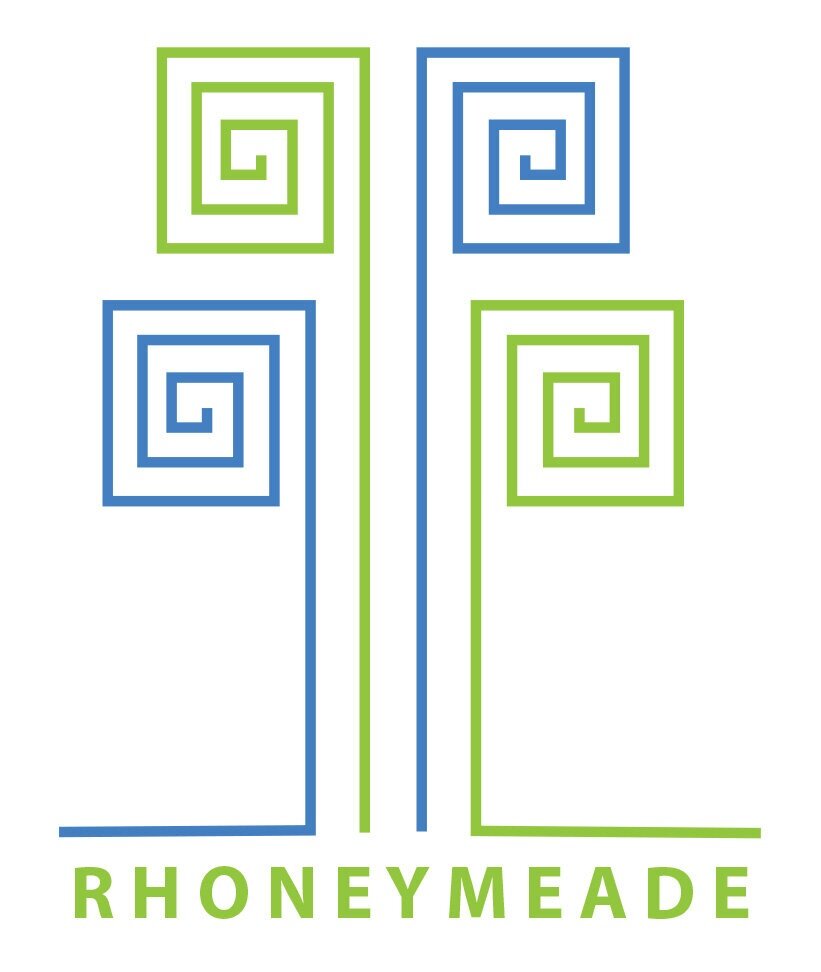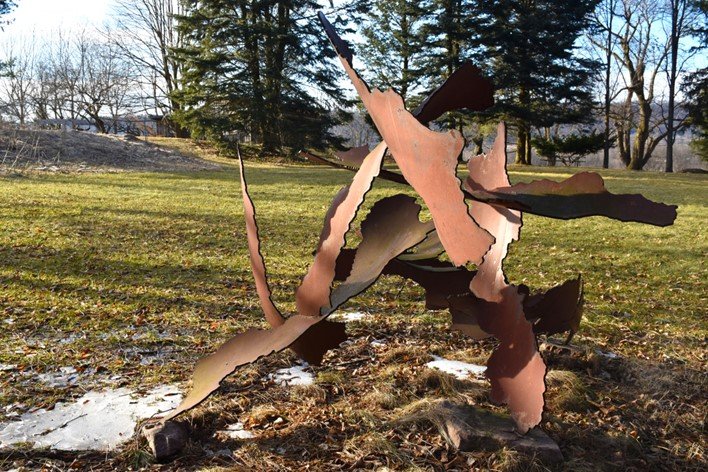Sculpture Garden
Our Sculpture Garden is full of many pieces made from various materials such as bronze, marble, wood, and iron. The material juxtaposes the organic shapes of plant life and also harmonizes quite beautifully. The artists of our permanent sculpture collection include:
If you would like to suggest a piece to join our permanent collection or an outdoor exhibition, please contact us below.
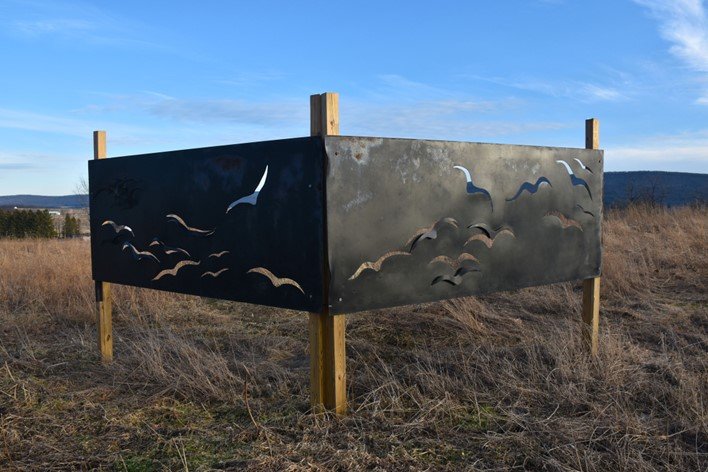
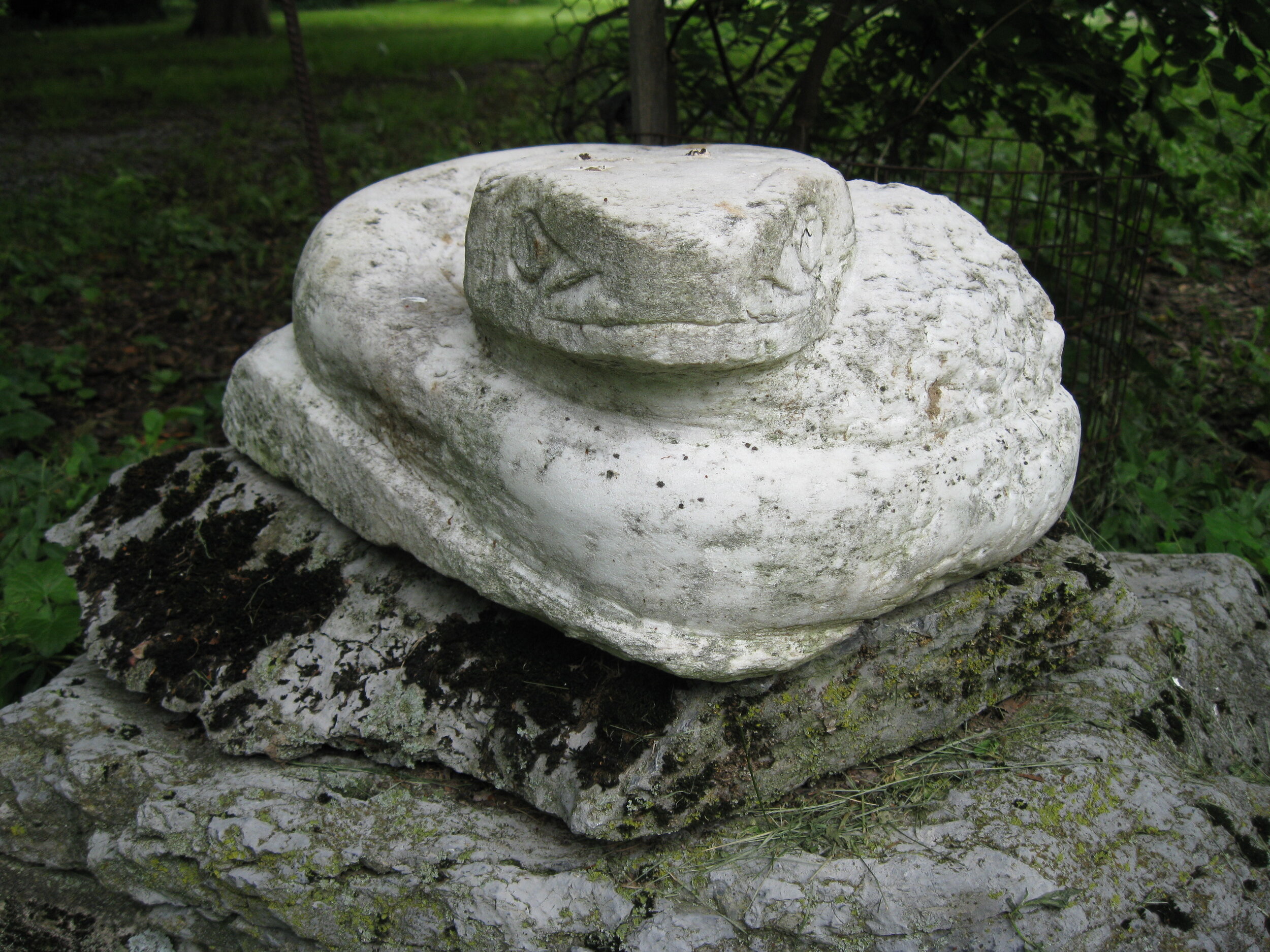
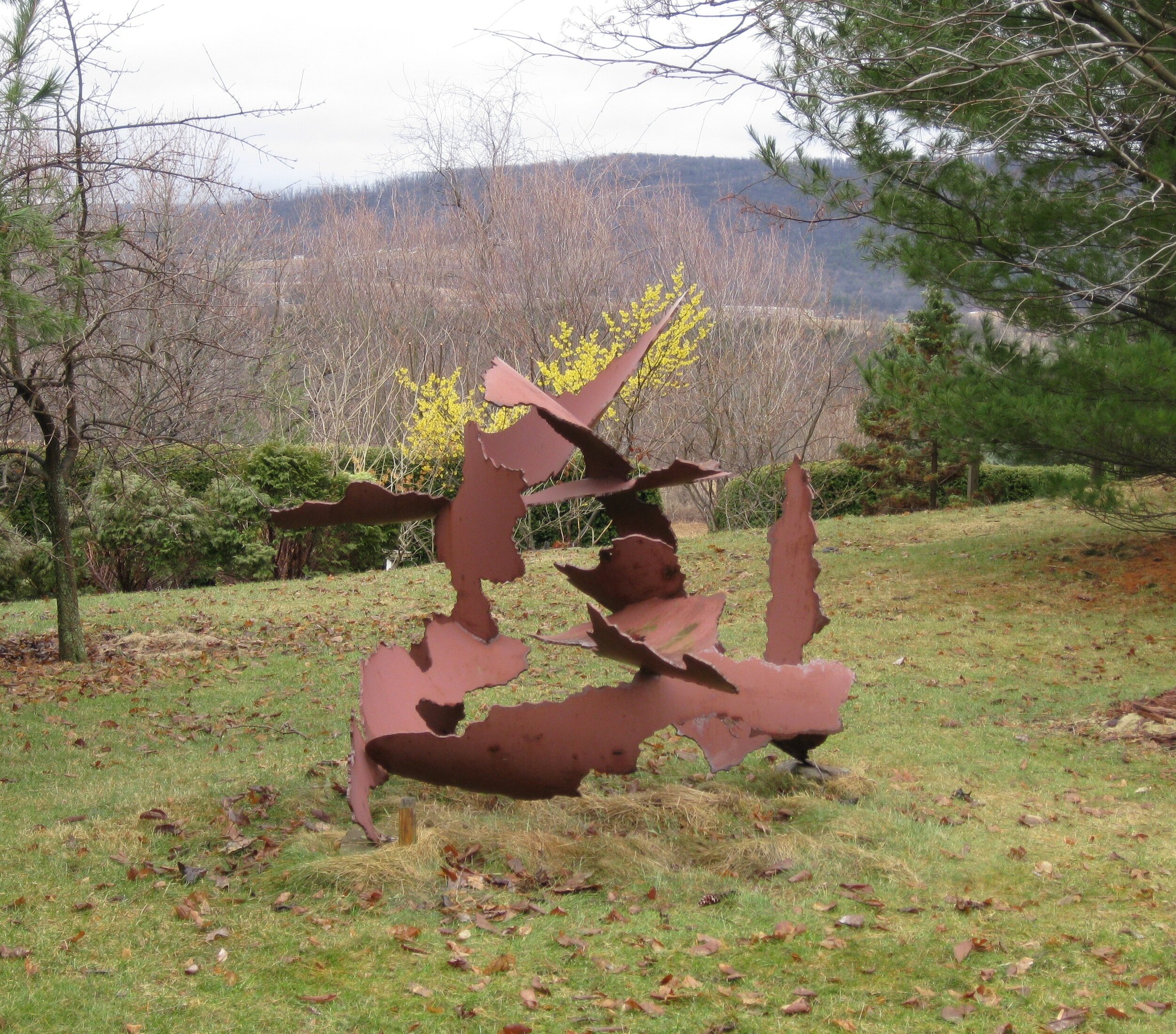
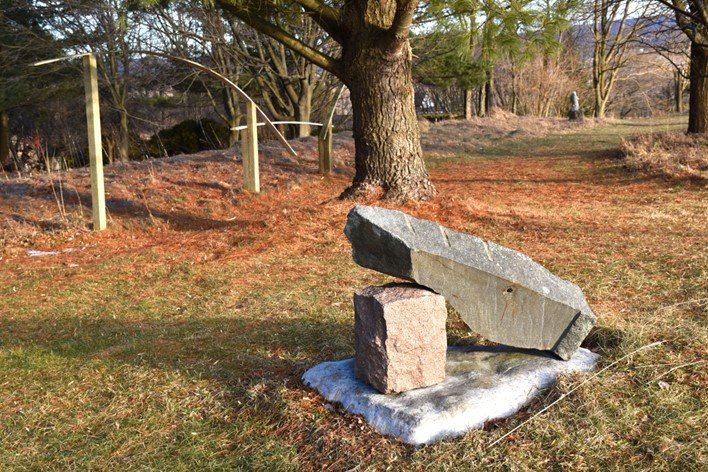
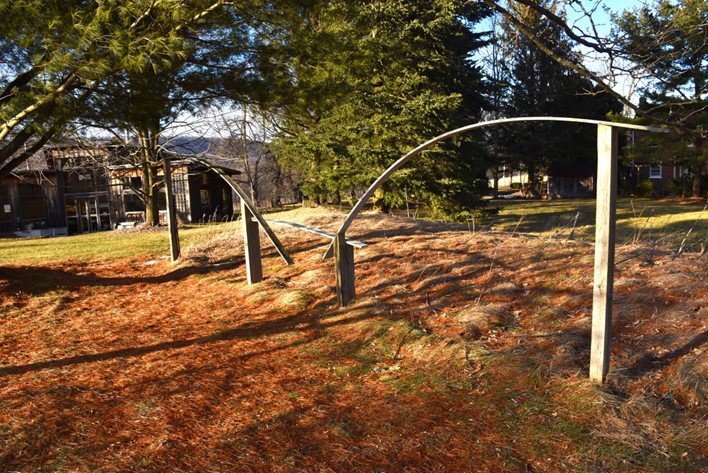
Explore the Sculptures
〰️
Explore the Sculptures 〰️
A ~ Jim Bright Tulipa Bronze 2005
ABOUT THIS SCULPTURE
In 2005, this bronze sculpture was created specially for the Rhoneymeade Arboretum and Sculpture garden. Richard Morgan, Rhoneymeade’s founder, commissioned Jim Bright for the work. Morgan wanted the piece to be placed a site on the northwest corner of the sculpture grounds.
Richard was intrigued by a concept that he called “three fold symmetry. His wish was to have a bronze that would speak to this vision. The environment in which the sculpture would preside also used the three fold concept. A landscape plan that invited visitors to select one of three entrances, each of which, spiraled into a meditative resting place for both sculpture and viewer. Our discussions of nature and symmetry lead me to produce sketches, maquettes and a 3’ wax form that would be cast in bronze. My desire was to honor both Richard’s vision and the quiet natural setting for the work. A.R.T. (Art Research & Technology) of Lancaster, PA invited Richard and I to view and participate in the casting of the finished work
Richard and Jim sit in front of Tulipa after its initial installation.
ABOUT THE ARTIST
Studying Art Education, Fine Arts, and Sculpture at Penn State and Indiana University of Pennsylvania, Bright has worked at the Creative Art Studios in Lucca, Italy. When he returned to the United States, he began teaching art to high school students in Lewistown. He has taught adult sculpture classes at the Art Alliance and works daily in his studio. Central Pennsylvania provides Jim with a supply of rich subject matter for his sculptures. Bright’s method of producing a sculpture is a strenuous and lengthy process. It begins with inspiration and sketching and ends with a fully developed three-dimensional form from local hardwoods, bronze or stone. Jim chooses to use the time-honored processes of carving and casting because the cadence of both allow time for ideas to mature and evolve. With each one, he simplifies and refines by gradually ‘carving away’ layers of nonessentials. Clarity and simplicity are his constant goals.
“Time and the elements have made Tulipa’s patina richer and it’s setting more mature. The recent addition of a stone plinth and capstone help complete the site, and hopefully Richard’s vision. Surely, a full realization of that vision would include Rhoneymeade’s visitors … sitting or standing inside that quiet spot.” - Jim Bright
B ~ Julian Thomas Flight Steel
ABOUT THIS SCULPTURE
In 1997, Rhoneymeade hosted an outdoor regional sculpture show featuring this piece by Julian Thomas. Dr. Morgan was so taken by it, he offered to buy Flight as a permanent addition to Rhoneymeade’s Sculpture garden.
C ~ Roger Pollok Lantern Bronz
ABOUT THE ARTIST
Roger is a geologist by trade, digs his own clay and makes many of his tools. He studied Geology in Ohio and went to graduate school at Penn State studying clays. He took a pottery class in 1968 and because of his knowledge of clay, decided to learn how to sculpt on his own. Through this process, Roger continues to learn and create many awe inspiring pieces. He started with small masks of the face which evolved into larger pieces like Lantern.
Roger also created many pieces that connect to the local history of Central Pennsylvania. This plaque was made in honor of the Bicentennial celebration of Bellefonte and is currently housed in the Rhoneymeade’s main house located within the Rhode Gallery.
A Demonstration of Roger making sculpture.
D ~ Richard Morgan Gnomon Granite
ABOUT THE ARTIST
Richard Morgan was the founder of the Rhoneymeade Arboretum and Sculpture Garden. His vision was to create a place where visitors could enjoy, learn about, and enrich their souls through art and nature. He was born July 5, 1926, in New York City and died Aug. 23, 2015, at age 89, where he had been a longtime professor of molecular biology at Penn State University. Richard attended Andover and then started college in the The V-12 Navy College Training Program. He graduated from Princeton in 1948, earned a medical degree at Columbia, and served in the Air Force until 1953. Fascinated by the molecular structure of protein molecules, Morgan decided to change his career path from medicine to Molecular Biology. Morgan often had his students build heir own molecules, helping them understand molecular structures spatially. After retiring, Morgan took sculpture classes at the Art Alliance of Central Pennsylvania as well as in his birth state of Vermont at the Southern Vermont Art Center. These experiences inspired Morgan to create the Rhoneymeade Arboretum and Sculpture Garden.
E ~ Kevin O’Toole Three Arches Cedar
ABOUT THE ARTIST
Born in St. Louis, Missouri, Kevin O'Toole graduated with a MFA from The Pennsylvania State University, and a BFA from Cornell University after studying at the Tyler School of Art in Rome. Kevin's works have been exhibited widely, and can be found in public and private collections around the country.
ABOUT THIS SCULPTURE
Three arches is representational of Kevin’s earliest work while earning his MFA from Penn State. Designed first as a clay model, this piece was then scaled up into laminated hardwood, kiln dried boards glued together to create a stable mass. Although Kevin doesn’t consider himself a wood worker, he rarely uses other materials when creating his work. Rhoneymeade is fortunate to have one of Kevin’s earlier works.
F ~ Mary Lee Kerr Twisting Torso Cement
ABOUT THIS SCULPTURE
Mary created this piece for a solo exhibition held at Rhoneymeade. This figurative clay sculpture entitled, twisting torso, captures the both the stability and flexibility found within a human trunk.
ABOUT THE ARTIST
Mary Lee Kerr has been creating portrait and figurative sculpture for over 30 years. From the first time she dug into a block of moist clay, she knew sculpture was her medium. Mary brings life to the clay in her hands, expressing something about her place in the world. Mary has studied and created clay sculptures, gradually mastering the technical aspects of the medium and constantly searching for the best way to express her ideas. While she has created some purely abstract sculptures, she also returns again and again to the face and figure as the best vehicles for expressing human emotion. She received training at art schools and studios around the country, including the Torpedo Factory in Virginia, the Loveland Academy of Art in Colorado, the Scottsdale Artists' School in Arizona, Touchstone Center for Crafts in Pennsylvania, the University of North Carolina at Chapel Hill, and Penland School of Craft in North Carolina. She has exhibited her work in galleries and art shows in North Carolina, Pennsylvania, and Australia.
G ~ Eric Stephenson Torso Weathered Steel
ABOUT THIS ARTIST
Eric W. Stephenson is an American sculptor based in Chicago whose work explores the form, spirit, and experience of the body, human and otherwise, rendered through abstraction and informed by industrial materials and methods. One such trajectory of work focused on the earthly remnants of insects and plants, another on commemorative containers for the human spirit. His most recent work returns to the human form to figure a language of movement through a mastery of metal.
Stephenson has taught at the University of Houston, Rhode Island College, and the Art Institute of Chicago, and has taught workshops at the University of Kentucky, Humboldt State University, and multiple International Sculpture Conferences, among others. His work has been shown at Fusion MIA during Art Basel Miami, the Elmhurst Museum, N’namdi Gallery, the Koehnline Museum, Grounds for Sculpture, and the Frederick Meijer Sculpture Garden, among others. Stephenson’s work is found in numerous private and public collections, including Miller Electric in Appleton, Wisconsin, from whom he won the First Biennial Miller Sculpture Exhibition Purchase Prize, the Elmhurst Museum, the Village of Oak Park, and Delta College in Midland, Michigan. Stephenson received his BFA from the Pennsylvania State University and MFA from the University of Houston, and in 2014 completed a SIM Residency in Reykjavik, Iceland.
Under Stephenson’s leadership as president of non-profit Chicago Sculpture International from 2011-2015, the organization expanded
the reach and profile of sculpture in Chicago through strategic partnerships, high-profile shows, and extensive media coverage. For the 2012 International Sculpture Conference in Chicago, for example, CSI partnered with Podmajersky to site six immersive installations in storefronts in Pilsen, and with the Chicago Parks District to place 64 large works along the Chicago lakefront from Promontory Point on the south side to Belmont Harbor on the north side. In 2013, CSI and the Chicago Parks District launched The Chicago Tree Project, which commissioned sculptors to transform dead trees throughout the city into public art pieces, while in 2014, the Elks National Memorial hosted the critically acclaimed “Invoking the Absence.”
Founded in Chicago by Eric Stephenson, Lunar Burn Studio LLC focuses on sculpting techniques using materials that are transformed by fire: metal, ceramic, and glass. For instructional techniques and further information about the artist and his work, check out his YouTube channel:
H ~ Richard Morgan Wolf Marble
ABOUT THIS SCULPTURE
Richard had a life long connection to learning. Over the years, he became fascinated by wolves and began collecting images and articles he found related to wolves and their social behaviors. By studying this particular animal’s behaviors and comparing to his own, Richard felt he was able to learn more about himself. In this sculpture, Richard conveys the wolf’s ability to navigate through life with confidence and strength.
ABOUT THE ARTIST
Richard Morgan was the founder of the Rhoneymeade Arboretum and Sculpture Garden. His vision was to create a place where visitors could enjoy, learn about, and enrich their souls through art and nature. He was born July 5, 1926, in New York City and died Aug. 23, 2015, at age 89, where he had been a longtime professor of molecular biology at Penn State University. Richard attended Andover and then started college in the The V-12 Navy College Training Program. He graduated from Princeton in 1948, earned a medical degree at Columbia, and served in the Air Force until 1953. Fascinated by the molecular structure of protein molecules, Morgan decided to change his career path from medicine to Molecular Biology. Morgan often had his students build heir own molecules, helping them understand molecular structures spatially. After retiring, Morgan took sculpture classes at the Art Alliance of Central Pennsylvania as well as in his birth state of Vermont at the Southern Vermont Art Center. These experiences inspired Morgan to create the Rhoneymeade Arboretum and Sculpture Garden.
I ~ William Lasansky Linear B Maine Granite
ABOUT THIS SCULPTURE
Linear B refers to the chart used to translate the language discovered from ancient ruins found on the island of Crete. Micael George Francis Ventures, an English architect and scholar, along with John Chadwick where responsible for the decipherment of Linear B. As an Art History and Sculpture professor, Lasansky created this piece to communicate the similarities between the Linear B language and language of sculpture.
ABOUT THE ARTIST - Sculptor William Lasansky’s home and studio are right where you might expect them to be on Vinalhaven: perched on the edge of a quarry, up the street from a cemetery full of carved monuments and a stone’s throw from the rocky shoreline. That he is an artist working with granite is no surprise. He has had a home on the island for many years, since coming with his family as a child. By his teens, he was fascinated with the craft of quarrying. He explored the island, observing the differences in granite, where it was located and how it was cut. He is a self-taught student of Vinalhaven granite history. Lasansky went on to become a teacher, and has just retired from the faculty of Bucknell University in Pennsylvania where he was a long-time professor of sculpture in the Department of Art and Art History.
One of the things he likes best about stone is the long relationship humans have had with stone. Lasansky appreciates not only the local tradition of stone quarrying and carving, but in other epochs and cultures as well. He refers to carved stone in Mexico, Peru, the Pacific Northwest, Britain, Italy and Egypt. Elements of those have a subtle influence in his work. But primarily what one sees in Lasansky’s sculpture is layers of story, of rocks given the means to reveal something. It is not only communicated through the visual. Like any good sculpture, his asks to be touched, and he welcomes that. Lasansky talks about how, in earlier societies, the manipulation of the environment was crucial to survival. People had to be tactile. He likes creating pieces that elicit and reconnect us with that instinct. His work combines his own sculpting with that of other forces acting on rock: time, weather, water and previous human interactions. Sometimes lichen still grows on them. Polished surfaces emerge and undulate, juxtaposed with areas rough or gouged. Lasansky describes conveying “a visually viable balance between untouched areas of primordial material and those areas the chisel consciously animates.”
Lasansky’s sculptures are powerfully evocative. They can be interpreted diversely as fragments of ancient temples or primitive altars, as artifacts of indigenous iconography, and as bold abstractions emphasizing line and form.
J ~ Malcolm Mubuto Smith Pillar Ceramic
ABOUT THE ARTIST
Malcolm is an artist and teacher, currently Associate Professor of Ceramic Art at Indiana University in Bloomington, Indiana. He earned an MFA from the New York State College of Ceramics at Alfred University in 1996 and studied at the Kansas City Art Institute and Penn State University where he completed a BFA in ceramics in 1994.
His works, both ceramic and drawing, are guided by improvisations that fluctuate between volumetric forms with graphic flatness. The vessels are inspired by the intersections of graffiti art, comic books, and playful organic abstraction. Generally, his ceramics forms rely on wheel-thrown and hand-built elements, most commonly presented as abstractions of cups, bottles, and vases. In this making practice, he merges these forms with his passion for Hip Hop and Jazz as locations for invention and the unexpected. The decorative objects operate as signifiers of acculturation to aesthetic things reflecting back to us our aestheticized desires and imaginations. Motivated by these concerns and his own multi-faceted/multi- cultural background, his research blends identity politics, CAD/CAM, printmaking, and drawing into a complex web of influences and passions.
K ~ Sigrid Christensen Gruppo Uno Bronze
ABOUT THE ARTIST
An inspired and gifted artist, Ms. Christensen was a 1965 graduate of the Rhode Island School of Design in Providence and received a Masters Degree and Graduate Degree from Villa Schifanoia in Florence, Italy in 1971 after studying sculpture there on a two-year fellowship from Rosary College. In the spring of 1971, Ms. Christensen was chosen by the Villa Schifanoia faculty to present a piece of her work to Pope Paul at St. Peter's Basilica, and the winged crucifix, sculpted in silver, is now a part of the permanent collection in the Vatican Museum in Rome. Ms. Christensen returned to the US in 1972 and taught art for many years in several schools and universities on the East Coast and California, including Penn State.
L ~ Amalia Shaltiel Piglet Ceramic
ABOUT THE ARTIST
Amalia was born in Israel and received a Master of Fine Arts from a joint program of The New York Studio School and Parsons School of Design in NYC in the early eighties. Since then, she has lived in Israel, NYC, in State College, PA and now in East Haddam, CT. She Richard Morgan’s, the founder of Rhoneymeade, instructor at the Art Alliance of Central Pennsylvania. As an artist she explores her life's journey. The process of creation is just as important to her as the finished result. She works towards an authentic statement of her experience of this earth, through the materials and through her subject matter. She sees the world as a dynamic interactive conversation. Her sculptures provide a sense of multiplicity through the movement in the form. Her sculptures do not reference objects. They are dynamic movement in static form, referencing her longtime Tai Chi practice.
M ~ Adam Leiden Friendly Ceramic
N ~ Daniel Bartasavich Thoughtful Man Plaster and Resin
O ~ Richard Morgan Natural Elegance Bronze
ABOUT THIS SCULPTURE
Richard and James Letcher marauded a piece of wood across from Schempfs place and from which Richard created this sculpture.
ABOUT THE ARTIST
Richard Morgan was the founder of the Rhoneymeade Arboretum and Sculpture Garden. His vision was to create a place where visitors could enjoy, learn about, and enrich their souls through art and nature. He was born July 5, 1926, in New York City and died Aug. 23, 2015, at age 89, where he had been a longtime professor of molecular biology at Penn State University. Richard attended Andover and then started college in the The V-12 Navy College Training Program. He graduated from Princeton in 1948, earned a medical degree at Columbia, and served in the Air Force until 1953. Fascinated by the molecular structure of protein molecules, Morgan decided to change his career path from medicine to Molecular Biology. Morgan often had his students build heir own molecules, helping them understand molecular structures spatially. After retiring, Morgan took sculpture classes at the Art Alliance of Central Pennsylvania as well as in his birth state of Vermont at the Southern Vermont Art Center. These experiences inspired Morgan to create the Rhoneymeade Arboretum and Sculpture Garden.
P ~ Eugene Lederer Lily Bronze
ABOUT THE ARTIST
Eugene W. Lederer, a State College native, was an attorney by trade with a deep connection to art and music. He graduated from Penn State with a degree in Music Education and attended law school at the University of Pennsylvania. He also served as a visiting lecturer in the Department of Political Science at Penn State. A true renaissance man, Lederer had many interests and hobbies. Not until after he retired, did he decide to take up sculpting and formal art training. It was through participating in classes at the Art Alliance that Lederer and Rhoneymeade’s founder, Richard Morgan, became good friends. Through this friendship, Lederer helped Morgan curate sculpture shows and further develop Rhoneymeade.
ADDITIONAL INFORMATION
Lederer was also a generous philanthropist. He founded the Art Alliance of Central Pennsylvania. In addition, Lederer donated the land to create Lederer Park in State College. A sculpture he made of his mother, Lucy can be found at Lederer Park.
Q ~ James Lindzey Two Figures Cast Aluminum
R ~ Rob Hainey Welcome Arch Walnut and Steel
ABOUT THIS SCULPTURE
This piece was created by Rob Hainey and Josh Cunningham.
S ~ Richard Morgan Zeitgeist Bronze
ABOUT THIS SCULPTURE
In 2011, Richard saw a photo of Rick Santorum in the Centre Daily Times that inspired this sculpture entitled Zeitgeist. “Politicians are always found in this pose”, said Morgan. Morgan did not have kind words for Pennsylvania office holders of the time and thought that this picture represented the extreme ideology that he felt Santorum endorsed.
ABOUT THE ARTIST
Richard Morgan was the founder of the Rhoneymeade Arboretum and Sculpture Garden. His vision was to create a place where visitors could enjoy, learn about, and enrich their souls through art and nature. He was born July 5, 1926, in New York City and died Aug. 23, 2015, at age 89, where he had been a longtime professor of molecular biology at Penn State University. Richard attended Andover and then started college in the The V-12 Navy College Training Program. He graduated from Princeton in 1948, earned a medical degree at Columbia, and served in the Air Force until 1953. Fascinated by the molecular structure of protein molecules, Morgan decided to change his career path from medicine to Molecular Biology. Morgan often had his students build heir own molecules, helping them understand molecular structures spatially. After retiring, Morgan took sculpture classes at the Art Alliance of Central Pennsylvania as well as in his birth state of Vermont at the Southern Vermont Art Center. These experiences inspired Morgan to create the Rhoneymeade Arboretum and Sculpture Garden.
T ~ Richard Morgan Spathe Cement
ABOUT THIS SCULPTURE
According the the Western Dictionary, a spathe is a large sheathing bract enclosing the flower cluster of certain plants, especially the spadix of arums and palms. Morgan called this piece an example of forest form. It’s interesting how this particular shape is found again and again in nature. Viewers of this sculpture have mentioned seeing an ear, ferns, a shell, and a peacock to name a few.
ABOUT THE ARTIST
Richard Morgan was the founder of the Rhoneymeade Arboretum and Sculpture Garden. His vision was to create a place where visitors could enjoy, learn about, and enrich their souls through art and nature. He was born July 5, 1926, in New York City and died Aug. 23, 2015, at age 89, where he had been a longtime professor of molecular biology at Penn State University. Richard attended Andover and then started college in the The V-12 Navy College Training Program. He graduated from Princeton in 1948, earned a medical degree at Columbia, and served in the Air Force until 1953. Fascinated by the molecular structure of protein molecules, Morgan decided to change his career path from medicine to Molecular Biology. Morgan often had his students build heir own molecules, helping them understand molecular structures spatially. After retiring, Morgan took sculpture classes at the Art Alliance of Central Pennsylvania as well as in his birth state of Vermont at the Southern Vermont Art Center. These experiences inspired Morgan to create the Rhoneymeade Arboretum and Sculpture Garden.
U ~ Joe Mooney Icarus Steel
ABOUT THIS SCULPTURE
Icarus was part of Mooney’s eleven piece exhibition series entitled “Facets”. Each sculpture was made of steel and reflects the many dimensions of Mooney’s personality. Mooney is drawn to the physicality involved when working in steel. He prefers to show his cutting edges revealing his hand in the work as well creating a more tactile appearance. The lines curve and turn while creating each piece resulting in a form that is caught in both space and time.
ADDITIONAL INFORMATION
In 1986 Richard Morgan acquired a piece of sculpture from Joe Mooney at The Central Pennsylvania Festival of The Arts. Joe and
Richard became friends and Joe helped helped Rhoneymeade organize its first Regional Invitational Outdoor Sculpture Shows from 1992 - 1996.
ABOUT THE ARTIST
“My work is the romance of the soul filtered through the rationality of thought; exploring myths and personal experiences through steel. The celebration of the positive.”
Joe Mooney is an avid reader, gaining inspiration from the words and stories he has consumed over a life time. He has exhibited his work at the Kouros Gallery New York, Museo De Arte Contemporaneous De Monterrey, Mexico, the Michener Museum and the Woodmere Museum of Art, as well as many others throughout the country. His commissions and corporate collections include George Washington University, Washington, D. C., Berman Museum at Ursinus College, PA, Moore College of Art, Philadelphia, PA, Quiet Waters Sculpture Park, Annapolis, MD, among others.
Education
MFA 1980 Alfred University, Alfred, New York
BFA 1978 Pennsylvania State University, University Park, PA
BS 1974 Villanova University, Villanova, PA
V ~ Sigrid Christensen Entwined Figures Bronze
ABOUT THE ARTIST
An inspired and gifted artist, Ms. Christensen was a 1965 graduate of the Rhode Island School of Design in Providence and received a Masters Degree and Graduate Degree from Villa Schifanoia in Florence, Italy in 1971 after studying sculpture there on a two-year fellowship from Rosary College. In the spring of 1971, Ms. Christensen was chosen by the Villa Schifanoia faculty to present a piece of her work to Pope Paul at St. Peter's Basilica, and the winged crucifix, sculpted in silver, is now a part of the permanent collection in the Vatican Museum in Rome. Ms. Christensen returned to the US in 1972 and taught art for many years in several schools and universities on the East Coast and California, including Penn State.
W ~ Joe Mooney Dream Steel
ABOUT THIS SCULPTURE
Dream was part of Mooney’s eleven piece exhibition series entitled “Facets”. Each sculpture was made of steel and reflects the many dimensions of Mooney’s personality. Mooney is drawn to the physicality involved when working in steel. He prefers to show his cutting edges revealing his hand in the work as well creating a more tactile appearance. The lines curve and turn while creating each piece resulting in a form that is caught in both space and time.
ADDITIONAL INFORMATION
In the early 1980’s, Rhoneymeade’s founder, Richard Morgan, first saw one of Joe’s sculptures at the Central Pennsylvania Festival of the Arts. Richard was so inspired by Joe’s work that he not only bought one of his sculptures, he also began taking sculpting classes himself. Joe Mooney helped Richard Morgan organize Rhoneymeade’s first Invitational Outdoor Sculpture Shows from 1992 - 1996.
ABOUT THE ARTIST
“My work is the romance of the soul filtered through the rationality of thought; exploring myths and personal experiences through steel. The celebration of the positive.”
Joe Mooney is an avid reader, gaining inspiration from the words and stories he has consumed over a life time. He has exhibited his work at the Kouros Gallery New York, Museo De Arte Contemporaneous De Monterrey, Mexico, the Michener Museum and the Woodmere Museum of Art, as well as many others throughout the country. His commissions and corporate collections include George Washington University, Washington, D. C., Berman Museum at Ursinus College, PA, Moore College of Art, Philadelphia, PA, Quiet Waters Sculpture Park, Annapolis, MD, among others.
Education
MFA 1980 Alfred University, Alfred, New York
BFA 1978 Pennsylvania State University, University Park, PA
BS 1974 Villanova University, Villanova, PA
X ~ Richard Morgan Sir Thomas Browne Marble
ABOUT THIS SCULPTURE
Here are the notes found in one of Richard Morgan’s journals regarding this sculpture. “Sr. Thomas Browne began to take his present form during the summer of 1989 at Marjorie Lutz’ sculpture class at the Southern Vermont Artist’s Studio in Manchester, VT. I brought this rough block of discarded quarry marble to class, and soon we could see Ram’s horns emerging from his head. So, for a while, TB was called “Pan”. A visiting friend saw a likeness to the 17th century English Physician of Norwich, Thomas Browne. He was known fore displaying a deep curiosity of the natural world and wrote with wit and subtle humor. For example, Browne’s tomb stone contained the following quote “Time, which antiquates antiquities, hath yet preserved these minot monuments.” So, I kept the horns, carved some ruffles on his shirt-front and a tolerant smile on his lips, and voila, Sir TB was born. TB was the first sculpture to be a permanent addition to the Rhoneymeade Sculpture Garden.”
ABOUT THE ARTIST
Richard Morgan was the founder of the Rhoneymeade Arboretum and Sculpture Garden. His vision was to create a place where visitors could enjoy, learn about, and enrich their souls through art and nature. He was born July 5, 1926, in New York City and died Aug. 23, 2015, at age 89, where he had been a longtime professor of molecular biology at Penn State University. Richard attended Andover and then started college in the The V-12 Navy College Training Program. He graduated from Princeton in 1948, earned a medical degree at Columbia, and served in the Air Force until 1953. Fascinated by the molecular structure of protein molecules, Morgan decided to change his career path from medicine to Molecular Biology. Morgan often had his students build heir own molecules, helping them understand molecular structures spatially. After retiring, Morgan took sculpture classes at the Art Alliance of Central Pennsylvania as well as in his birth state of Vermont at the Southern Vermont Art Center. These experiences inspired Morgan to create the Rhoneymeade Arboretum and Sculpture Garden.
Y ~ Richard Morgan Homage to Henri Bronze
ABOUT THE ARTIST
Richard Morgan was the founder of the Rhoneymeade Arboretum and Sculpture Garden. His vision was to create a place where visitors could enjoy, learn about, and enrich their souls through art and nature. He was born July 5, 1926, in New York City and died Aug. 23, 2015, at age 89, where he had been a longtime professor of molecular biology at Penn State University. Richard attended Andover and then started college in the The V-12 Navy College Training Program. He graduated from Princeton in 1948, earned a medical degree at Columbia, and served in the Air Force until 1953. Fascinated by the molecular structure of protein molecules, Morgan decided to change his career path from medicine to Molecular Biology. Morgan often had his students build heir own molecules, helping them understand molecular structures spatially. After retiring, Morgan took sculpture classes at the Art Alliance of Central Pennsylvania as well as in his birth state of Vermont at the Southern Vermont Art Center. These experiences inspired Morgan to create the Rhoneymeade Arboretum and Sculpture Garden.
Z ~ Anonymous Donor Fish Welded Steel
AA ~ Richard Morgan Serpent Vermont Marble
ABOUT THIS SCULPTURE
Morgan took his inspiration for this piece after learning more about pit viper snakes. With over 60 species, locally rattle snakes, copper heads and water moccasin are pit vipers native to Pennsylvania.
ABOUT THE ARTIST
Richard Morgan was the founder of the Rhoneymeade Arboretum and Sculpture Garden. His vision was to create a place where visitors could enjoy, learn about, and enrich their souls through art and nature. He was born July 5, 1926, in New York City and died Aug. 23, 2015, at age 89, where he had been a longtime professor of molecular biology at Penn State University. Richard attended Andover and then started college in the The V-12 Navy College Training Program. He graduated from Princeton in 1948, earned a medical degree at Columbia, and served in the Air Force until 1953. Fascinated by the molecular structure of protein molecules, Morgan decided to change his career path from medicine to Molecular Biology. Morgan often had his students build heir own molecules, helping them understand molecular structures spatially. After retiring, Morgan took sculpture classes at the Art Alliance of Central Pennsylvania as well as in his birth state of Vermont at the Southern Vermont Art Center. These experiences inspired Morgan to create the Rhoneymeade Arboretum and Sculpture Garden
BB ~ Richard Morgan Crown of Fronds Bronze
ABOUT THE ARTIST
Richard Morgan was the founder of the Rhoneymeade Arboretum and Sculpture Garden. His vision was to create a place where visitors could enjoy, learn about, and enrich their souls through art and nature. He was born July 5, 1926, in New York City and died Aug. 23, 2015, at age 89, where he had been a longtime professor of molecular biology at Penn State University. Richard attended Andover and then started college in the The V-12 Navy College Training Program. He graduated from Princeton in 1948, earned a medical degree at Columbia, and served in the Air Force until 1953. Fascinated by the molecular structure of protein molecules, Morgan decided to change his career path from medicine to Molecular Biology. Morgan often had his students build heir own molecules, helping them understand molecular structures spatially. After retiring, Morgan took sculpture classes at the Art Alliance of Central Pennsylvania as well as in his birth state of Vermont at the Southern Vermont Art Center. These experiences inspired Morgan to create the Rhoneymeade Arboretum and Sculpture Garden.
CC ~ Richard Morgan Can-Can Bronze
ABOUT THIS SCULPTURE
This piece was inspired by the French cancan where the main features of the dance are lifting up and manipulating skirts with high kicking and suggestive, provocative body movements. The original can-can was given to one of Richard Morgan’s descendants, Hilary D. Proust.
ABOUT THE ARTIST
Richard Morgan was the founder of the Rhoneymeade Arboretum and Sculpture Garden. His vision was to create a place where visitors could enjoy, learn about, and enrich their souls through art and nature. He was born July 5, 1926, in New York City and died Aug. 23, 2015, at age 89, where he had been a longtime professor of molecular biology at Penn State University. Richard attended Andover and then started college in the The V-12 Navy College Training Program. He graduated from Princeton in 1948, earned a medical degree at Columbia, and served in the Air Force until 1953. Fascinated by the molecular structure of protein molecules, Morgan decided to change his career path from medicine to Molecular Biology. Morgan often had his students build heir own molecules, helping them understand molecular structures spatially. After retiring, Morgan took sculpture classes at the Art Alliance of Central Pennsylvania as well as in his birth state of Vermont at the Southern Vermont Art Center. These experiences inspired Morgan to create the Rhoneymeade Arboretum and Sculpture Garden.
